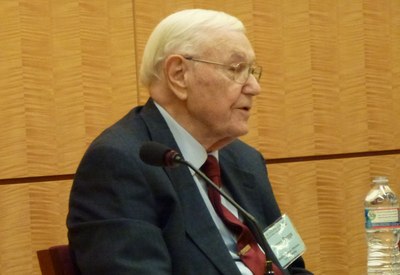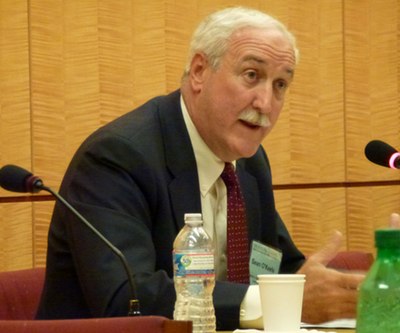
NASA’s past considers its futureby Jeff Foust
|
| “I can’t tell you how many times in the last few years I have been asked, ‘What do you think of NASA’s new direction?’” recalled Truly. “And I can’t answer that question. I am utterly confused.” |
Another exercise in studying NASA’s present situation and offering advice for the agency is underway. The fiscal year 2012 appropriations bill that funded NASA included report language directing the agency to undertake an independent assessment of its strategic direction. That study, the report mandated, would “evaluate whether NASA’s overall strategic direction remains viable and whether agency management is optimized to support that direction.”
NASA brought in the National Research Council to perform the “NASA’s Strategic Direction” study, which is currently underway. The committee has held a pair of public meetings, including one in late June that included presentations by a number of current NASA officials, including administrator Charles Bolden. The June meeting also featured three of Bolden’s predecessors: Richard Truly, James Beggs, and Sean O’Keefe. The perspectives of those former administrators in particular provided some interesting insights into both the agency’s past and its future.
Some former administrators, in their comments to the committee, raised concern about the future direction of NASA—or, more accurately, a perception that the agency lacks direction. “I can’t tell you how many times in the last few years I have been asked, ‘What do you think of NASA’s new direction?’” recalled Truly. “And I can’t answer that question. I am utterly confused.”
Truly, who served as NASA administrator from 1989 to 1992, left the space field behind after leaving NASA, eventually taking a position as director of the Department of Energy’s National Renewable Energy Laboratory in Colorado. He described himself to the committee today as “a citizen who lives way out there in the country” who watches NASA’s activities from afar.
Truly said that after President George W. Bush announced the Vision for Space Exploration, whose elements included the retirement of the Space Shuttle, he got comfortable with the idea of ending the shuttle program to help fund the future exploration systems. “But I never dreamed that the president then would not make another speech about the Vision” after his January 2004 address at NASA Headquarters, Truly said, and the program was not properly funded. He sounded disappointed that, when the Obama Administration decided to cancel the Constellation program in 2010, it did not decide to keep the shuttle going.
The confusion he said he experiences about NASA’s direction should be a concern, he warned. “But if I’m confused, and you multiply me by the millions of citizens who may also be confused, this is a dangerous situation for NASA. And that’s the reason that makes this study so important.”
Beggs, who was NASA administrator from mid-1981 through 1985, also expressed concern about NASA’s direction in his comments to the committee later the same day. He noted NASA’s 2011 strategic plan includes six specific goals, from “extend and sustain human activities across the solar system” to public outreach and fostering innovation.
“They are important in the sense that they do encompass that vision” laid out in the original Space Act that created the agency in 1958, he said. “Unfortunately, at this time, these goals have not been elucidated in such a way that they provide a clear framework and clear guidance to everyone in the agency.”
| “We are not adrift,” Bolden said. “I think you heard some of my predecessors talk about they don’t know where we’re going. That’s their problem, not mine.” |
“There’s a lot of uncertainty out there,” he continued. “The uncertainty is such that the folks who work in NASA and have been with NASA over the long term are not yet convinced that we have an appropriate plan.” Later, he said, “I still think we need a unifying mission. I am not satisfied with what they’re planning now is truly unified.” He suggested that a permanent base on the Moon should be that mission, citing interest in such missions from Russia and China.
Current administrator Bolden, who spoke to the committee the next day, rejected the suggestions from Beggs and Truly that NASA didn’t have a firm vision. “We are not adrift,” he said. “I think you heard some of my predecessors talk about they don’t know where we’re going. That’s their problem, not mine. I know where the agency is going. I know where I want it to go.”
 Former NASA administrator James Beggs said, “There is too much institution for the program, and there is too much program for the budget.” (credit: J. Foust) |
Another part of the testimony by NASA’s current and former leaders focused on the size and structure of the agency itself. That interest appeared to be triggered by one item in the project scope for the study: “Examine NASA’s organizational structure and identify changes that could improve the efficiency and effectiveness of the Agency’s mission activities.” To some, that sounded like code words for either closing centers or converting some into federally funded research and development centers (FFRDCs) run by other organizations. An example is JPL, which is funded by NASA but managed by Caltech.
Truly called out that that element of the project scope in his comments. “I hope you will stick to bigger stuff than that,” he cautioned, saying that the committee’s work should be at a higher level than reshaping organizational charts. “But if this is code for should we have this number of NASA centers going forward or not, fine.”
He warned that, based on his experience running an FFRDC for the Department of Energy, converting NASA centers to that structure may not be an ideal solution. While calling JPL one of the best examples of an FFRDC anywhere in the federal government, “I don’t think you want to trade the current NASA centers, that organization,” into FFRDCs. “I don’t think that’s a very good idea. And even if it was a good idea, I don’t understand what problem there is that this is the answer to.” He said that it would be a “nightmare” to transition centers to FFRDCs, and would be difficult to get them to work together once transitioned, citing the lack of cooperation among the Energy Department’s national labs.
Beggs also said he didn’t see a need to convert NASA centers into FFRDCs. “I’m a firm believer in the old slogan, ‘if it ain’t broke, don’t fix it,’” he said. “And I think the organizational structure of the agency is well-designed, well-structured, and it works. And I don’t see any reason to change it.”
| “We could have, I think easily would have, seen that conversion [of NASA centers to FFRDCs] occur a few years back had there been just a little more time,” O’Keefe said. |
One recent time that the idea of converting NASA centers into FFRDCs came up was in 2004 by the President’s Commission on the Implementation of United States Space Exploration Policy, or more commonly known as the Aldridge Commission after its chairman, Pete Aldridge. Its final report recommended a restructuring of NASA that would convert many of its centers into FFRDCs.
“FFRDCs provide a tested, proven management structure in which many of the federal government’s most successful and innovative research, laboratory, technical support, and engineering institutions thrive,” the report concluded. “The value of FFRDCs is rooted in their technical competence, flexibility, independence, and objectivity in support of a given federal agency’s technical projects.” It did recommend that centers involved with “specific governmental functions” like launch and flight operations not be transitioned into FFRDCs.
The NASA administrator at the time of the Aldridge Commission report, Sean O’Keefe, told the NRC committee he was open to that concept. “How do you rationalize ten different centers around the country?” he asked, suggesting that FFRDCs was one idea he pursued during his tenure and still worth consideration today.
“I was pleasantly surprised to find out how much enthusiasm there was for that [FFRDC approach] within the centers as well as within some of the universities” that might be asked to manage them. “We could have, I think easily would have, seen that conversion occur a few years back had there been just a little more time.” That was an apparent allusion to O’Keefe’s departure from NASA at the end of 2004 to become chancellor of Louisiana State University. He was replaced by Mike Griffin, who showed no particular interest in FFRDCs. O’Keefe said that the FFRDC conversion plan “became almost a victim of transitions.”
Even though who didn’t embrace the FFRDC concept acknowledged that NASA today has infrastructure that includes some relics of past programs no longer needed. “I would be less than honest if I told you we need everything we have,” Bolden admitted. “We don’t. There’s some stuff we don’t do anymore, and yet we have facilities that are capable of handling that if someone gave it to us. But in today’s budget environment, you really can’t honestly hope to maintain all that stuff, hoping that someday it will return when we know it won’t.”
“There is too much institution for the program,” Beggs concluded, “and there is too much program for the budget.”
 Former NASA administrator Sean O’Keefe said he had seen some enthusiasm within NASA to converting some field centers to FFRDCs, but the effort died after he left the agency in late 2004. (credit: J. Foust) |
Beggs’s solution to that conundrum was simple: increase NASA’s budget by $4–5 billion per year, which would give it enough money to carry out all its programs as well as future ones, like the lunar base he advocated for. “I really don’t understand how this great nation” can’t afford to spend more money on overall research and development, he said, on the order of two to three percent of the nation’s GNP. “Where is the leadership that we used to have?”
Such funding doesn’t appear to be forthcoming in today’s fiscal environment, where government officials regularly repeat the mantra “flat is the new up” regarding budgets. But NASA’s budget falling short of the desires of its advocates is nothing new.
| “There is too much institution for the program,” Beggs concluded, “and there is too much program for the budget.” |
“I never once encountered anybody who said, ‘We’ve got all the resources we need, thank you very much,’” O’Keefe recalled, going back to his time both at NASA and the Defense Department. “Instead, the bigger challenge is trying to figure out how to establish a range of priorities necessary in order to fit within what has been determined to be an appropriate investment level to do.” He said that while he would have appreciated a bigger budget while at NASA, “everything that was a priority, I never had a problem gaining the endorsement of the administration.”
“NASA’s program are so big and so expensive that presidential leadership and White House followup to give clear support to NASA as they carry them out is essential,” Truly said, along with key supporters in Congress. Public support is also key, he said. “NASA is lost if you allow confusion in what it’s doing among the citizens.”
What impact that testimony will have on the NRC’s final report, and what effect the report will have on the White House and Congress, will take months, if not years, to ascertain. But Bolden agreed that the NASA is at a rare point in its history. “We’re at a turning point in the agency today, as we were when I joined in 1980,” he said. He even suggested that the committee give its final report to Congress in a public session that “provokes public dialogue. If it doesn’t then the Congress has wasted your time.”